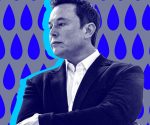An electric popemobile is Fisker’s latest leap of faith
[ad_1]
On May 21st, vehicle designer Henrik Fisker said he had a “private audience” with Pope Francis and that his company, Fisker Inc., would make a custom electric SUV to be used for official papal transport in late 2022. What he didn’t share was that the meeting took on a much different character than described, and that the proposal was something of a surprise.
An electric popemobile is the latest bold claim from Fisker, who raised nearly $1 billion for his company last year after previously touting a revolutionary solid-state battery and a manufacturing partnership with Volkswagen — each half-baked ideas that didn’t come to pass. And it comes at a time when a number of well-funded EV startups are facing intense scrutiny of the promises they make, big and small.
The day before the announcement, Fisker and his co-founder and wife, Geeta Gupta-Fisker, were among a group of people who briefly met with Pope Francis during an educational event at Palazzo San Callisto, outside the walls of Vatican City. Other attendees included former Uber board member Shervin Pishevar, who pitched the pope on his health startup, according to a post on his Instagram account.
In a video posted by the Vatican’s own news outlet last month, Gupta-Fisker can be seen asking the pope to bless the EV startup before having his holiness sign a marker-drawn sketch of the Fisker Inc. SUV. Moments later, Henrik Fisker spends roughly one minute talking to Pope Francis and shows him framed computer renderings of the proposed electric popemobile. After Fisker says he plans to deliver the electric SUV to the Vatican next year, an aide moves the CEO’s hands out of the way so the pope can see the next presentation.
The fleeting interaction was not listed on the Vatican’s list of official “audiences” for that day. But the following day, Fisker Inc. put out a press release saying the company is “set to develop the first all-electric vehicle for the Holy See, Pope Francis, after a historic visit to Vatican City” and that he and Gupta-Fisker “presented a vision for the design of an all-electric papal transport” to His Holiness during a “private audience” — despite the junket-style meeting taking place a mile from Vatican City. The release also didn’t say whether the Vatican actually agreed to use the vehicle. Still, Fisker tweeted: “Looking forward to make [sic] the 1st ALL electric Popemobile.”
Fisker Inc. now tells The Verge that the Fiskers’ “proposal was accepted” and that employees are working with the Vatican to understand its requirements for the vehicle but declined to offer more information. The Vatican’s press office did not respond to eight emails and two phone calls requesting comment over the past few weeks.
The Vatican has used a wide variety of vehicles over the years to ferry the pope around at public gatherings. Roughly one-third of those came from Mercedes-Benz, according to a 2015 article in The Washington Post that describes a number of the most famous vehicles. Daimler, Mercedes-Benz’s parent company, declined to comment on its relationship with the Vatican.
On international trips, the Vatican often tasks local automakers with turning around modified vehicles with the required added safety measures (like bulletproof glass). It has a habit of entering into contracts with these companies for these efforts, though the agreements stay private.
“Popemobile” is a colloquial term that the Vatican does not use, but it generally refers to the vehicles that the pope uses to greet the masses. That’s clearly what Fisker wants to deliver, given his tweet, the press release, and the renderings of an electric SUV with a glass box protruding from the roof.
But the Vatican is also sometimes gifted vehicles that don’t have those safety measures, which disqualifies them for official use and may not require a contract. In 2012, in fact, Renault gave the pope an electric Kangoo van that the Vatican said would only be used to get around the summer palace. So a pope has used an electric vehicle before, though one could argue that this wasn’t an electric popemobile.
Whatever Fisker ultimately sends to Italy, making a popemobile isn’t going to shape the future of Fisker Inc. — the startup’s survival depends far more on things like the manufacturing deal it announced with supplier Magna last week, or its partnership with Foxconn.
But there were reasons to be skeptical about the announcement beyond the disconnect between the casual nature of the event where the Fiskers made their pitch and the certainty with which the news was announced.
Shortly after Fisker Inc. was founded in 2016, The Truth About Cars discovered what appeared to be an astroturfing campaign that was leaving overwhelmingly positive comments on articles about the company. The report also claimed to have found a connection between some of the comments and Gupta-Fisker.
More recently, Fisker Inc. was hit with a previously unreported lawsuit in Los Angeles Superior Court by someone who briefly served as the startup’s VP of marketing in early 2020 — well before the company raised nearly $1 billion in its SPAC merger, and during a time when it was allegedly low on cash, according to the complaint. One of the claims the former VP makes in the lawsuit is that, while working there, Henrik Fisker and Geeta Gupta-Fisker asked her to “fill up the office” with unpaid interns to “make the company look better to potential investors.”
Fisker Inc. has denied both of these claims.
Fisker has also made big changes to his company’s plans in just a few short years. He once promoted a solid-state battery, and fundraised for the SPAC merger by promoting a partnership with Volkswagen that would have involved Fisker Inc. using the German automaker’s EV tech. But neither of those ideas worked out. Broken promises are already becoming a trend among EV startups that merged with SPACs, too. Just look at Lordstown Motors or Nikola.
So will Fisker actually make an electric popemobile? The company says it will, but the Vatican remains mum. At the very least, Fisker Inc. has more than enough money to put a glass box on one of its SUVs and call it one.
[ad_2]
Source link










